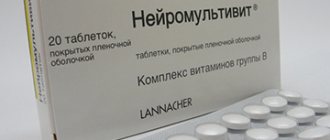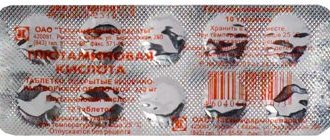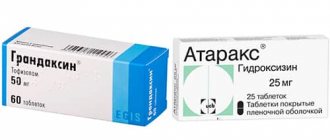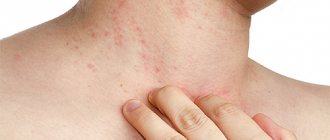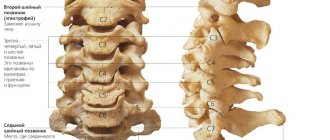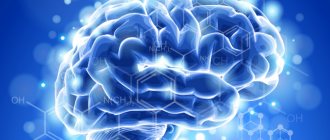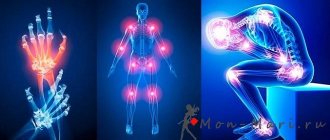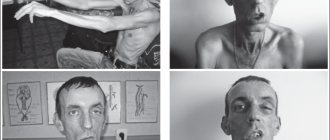The transfer of excitation from somatic nerves to skeletal muscles is carried out using acetylcholine. It is secreted by the presynaptic membrane and binds to n-cholinergic receptors; activation of the latter initiates a set of changes leading to muscle contraction. Strengthening contractile activity can be obtained with acetylcholine agonists or drugs that cause the accumulation of the transmitter in the synaptic cleft - anticholinesterase drugs (see).
Muscle relaxants have the opposite effect (see). The group of muscle relaxants includes drugs that relax skeletal muscles.
Substances included in the group of peripherally acting muscle relaxants are divided into antidepolarizers (pachycurare), depolarizers (leptocurare) and “mixed type”.
Curare and curare-like drugs are used in medicine to relax skeletal muscles, mainly during surgical operations. The effect of these drugs is associated with a shielding effect on n-cholinergic receptors of the postsynaptic membrane of striated muscles.
Curare is a mixture of condensed extracts from South American plants of the Strychnos
(
S. toxifera
, etc.) and
Chondodendron (Ch. Tomentosum, Ch. Platyphyllum
, etc.); It has long been used by the aborigines as poison for arrows (causing immobilization or death of the animal as a result of asphyxia caused by the cessation of contractions of the respiratory muscles). Even in the last century, it was established that the immobilization caused by curare depends on the cessation of the transmission of excitation from the motor nerves to the muscles (Claude Bernard, E.V. Pelikan).
In 1935 from "pipe" curare and Chondodendron tomentosum
isolated the main active ingredient - d-tubocurarine.
It turned out that synthetic curare-like compounds, some alkaloids and their derivatives have similar properties.
Antidepolarizing or non-depolarizing muscle relaxants (pachycurare) paralyze neuromuscular transmission, reducing the sensitivity of n-cholinergic receptors in the synaptic region to acetylcholine, eliminating the possibility of depolarization of the end plate and excitation of the muscle fiber. These include d-tubocurarine, diplacine dichloride, pipecuronium bromide, atracurium besylate, etc. Compounds of this group are true curare-like substances. Their antagonists are anticholinesterase substances: inhibition of cholinesterase leads to the accumulation of acetylcholine in the area of synapses, which, at increased concentrations, displaces curare-like substances from n-cholinergic receptors and restores neuromuscular conduction.
Depolarizers (leptocurare) relax the muscles, causing, on the contrary, persistent depolarization of the end plate, making it (like excess amounts of acetylcholine) unreceptive to new impulses and ultimately also disrupting the conduction of excitation from nerve to muscle. Drugs in this group are relatively quickly hydrolyzed by cholinesterase and, with a single administration, give a short-term effect; Of course, anticholinesterase drugs enhance their effect. The main representative of this group is suxamethonium iodide.
Some muscle relaxants may have mixed effects—antidepolarizing and depolarizing.
A number of drugs relax somatic muscles through central mechanisms. Muscle relaxation can be caused by anxiolytics (see). In recent years, compounds have been found (tolperisone, baclofen, tizanidine, etc.), the muscle relaxant effect of which is associated with a specific effect on the reticular formation of the brain, spinal mono- and polysynaptic reflexes. They eliminate the increased tone of voluntary muscles without significantly impairing motor functions. They are used for spastic conditions, lumbar radiculitis, rheumatic and other diseases accompanied by spasm of skeletal muscles. In the mechanism of action of these drugs, modulation of GABAergic processes in the brain plays an important role.
Symptoms of neuritis
The clinical picture of neuritis is determined by the functions of the nerve, the degree of its damage and the area of innervation. Most peripheral nerves consist of nerve fibers of different types: sensory, motor and autonomic. Damage to each type of fiber gives the following symptoms characteristic of any neuritis:
- sensitivity disorders - numbness, paresthesia (tingling sensation, “crawling sensations”), decreased or loss of sensitivity in the innervation zone;
- violation of active movements - complete (paralysis) or partial (paresis) decrease in strength in innervated muscles, development of their atrophy, decrease or loss of tendon reflexes;
- vegetative and trophic disorders - swelling, cyanosis of the skin, local hair loss and depigmentation, sweating, thinning and dry skin, brittle nails, the appearance of trophic ulcers, etc.
Typically, the first symptoms of nerve damage are pain and numbness. In the clinical picture of some neuritis, specific manifestations associated with the area innervated by this nerve may be noted.
Neuritis of the axillary nerve is manifested by the inability to raise the arm to the side, decreased sensitivity in the upper 1/3 of the shoulder, atrophy of the deltoid muscle of the shoulder and increased mobility of the shoulder joint.
Sensory disorders - the main group of symptoms
Manifestations of pathology in the leg area can be varied, often depending on the cause of neuropathy. If the disease is caused by injury, symptoms affect one limb. In diabetes mellitus and autoimmune diseases, symptoms spread to both legs.
Sensory disturbances can be so unpleasant that they cause depression in the patient.
Sensory disturbances occur in all cases of lower extremity neuropathy. Symptoms are usually observed constantly, do not depend on body position, daily routine, rest, and often cause insomnia.
In addition to the described signs, there are often sensory disturbances - slow recognition of cold and hot, changes in the pain threshold, regular loss of balance due to decreased sensitivity of the feet. Pains also often appear - aching or cutting, weak or literally unbearable, they are localized in the area of the affected area of the nerve.
Treatment of neuritis
Therapy for neuritis is primarily aimed at the cause that caused it. For infectious neuritis, antibacterial therapy (sulfonamides, antibiotics), antiviral drugs (interferon derivatives, gamma globulin) are prescribed. For neuritis resulting from ischemia, vasodilators are used (papaverine, aminophylline, xanthinol nicotinate); for traumatic neuritis, the limb is immobilized. Anti-inflammatory drugs (indomethacin, ibuprofen, diclofenac), analgesics, B vitamins are used and decongestant therapy is carried out (furosemide, acetazolamide). At the end of the second week, anticholinesterase drugs (neostigmine) and biogenic stimulants (aloe, hyaluronidase) are added to treatment.
Decompression. In the absence of signs of nerve recovery or the appearance of signs of its degeneration, surgical treatment is also indicated, which consists of suturing the nerve; in some cases, nerve plastic surgery may be required.
Main reasons for development
Neuropathy of the lower extremities is a very dangerous disease, which is accompanied by serious disorders and extremely unpleasant symptoms. The reasons for the development of pathology can be very different. In modern medicine, several risk factors are identified:
- various metabolic disorders caused by various chronic diseases, in particular renal failure;
- the presence of endocrine pathologies, namely: dysfunction of the thyroid gland, diabetes mellitus (diabetic neuropathy of the lower extremities is considered the most common);
- injuries, damage to certain structures of the peripheral nervous system;
- long-term exposure to toxic substances on the body (the list of potentially dangerous substances includes narcotic drugs, alcohol, acetone, arsenic, lead, mercury);
- severe, chronic vitamin deficiency;
- uncontrolled use of certain medications, for example, antitumor drugs, antibiotics;
- severe forms of infectious diseases, including mumps, diphtheria, chicken pox, HIV infection;
- systemic autoimmune pathologies, in which antibodies of the own immune system attack nerve cells and destroy myelin sheaths;
- the presence of malignant tumors in the body;
- it has been proven that there is a hereditary predisposition (for example, a genetic disease such as Charcot-Marie-Tooth amyotrophy is accompanied by the development of neuropathies).
Any of the above conditions can lead to the development of severe damage to nerve structures. During diagnosis, by the way, it is not enough to just confirm the presence of neuropathy of the lower extremities; it is also important to determine the cause of the development of the disease.
If polyneuropathy is suspected, you need to undergo several diagnostic procedures, including laboratory and instrumental studies.
After collecting an anamnesis, the doctor will conduct an external examination and examine reflexes, after which he will send you to the laboratory for blood testing, in addition, they will do an ultrasound of the internal organs, x-rays of the affected areas, and collect cerebrospinal fluid.
The choice of treatment regimen begins only after a full examination and diagnosis.
Drugs of first choice in the treatment of polyneuropathy, their therapeutic effect is aimed at improving blood circulation in the area of damage and improving tissue trophism, regeneration of nerve fibers.
Most often, medications from this list are included in the treatment regimen:
- Actovegin;
- Alpha lipoic acid;
- Instenon;
- Cerebrolysin;
- Mexidol;
- Cytochrome C;
The action of the drugs is aimed at: improving neuromuscular conduction, accelerating metabolism, improving the supply of tissues with blood and oxygen.
Metabolic agents are capable of: providing an antioxidant effect, fighting free radicals, stopping the processes of destruction of nervous tissue and promoting the restoration of impaired functions.
In the treatment process, an important role is played by B vitamins (B1, B12, B6). Preference is given to combination drugs that are released in tablet form or as injections.
Among the injection forms most often prescribed:
- Combilipen;
- Vitaxon;
- Vitagamma;
- Milgamma;
In addition to a set of vitamins, these medications include lidocaine, which additionally provides an analgesic effect.
After a course of injections, vitamin preparations are prescribed in tablet form: Neurobion, Neuromultivit, Keltican.
For polyneuropathy, the use of painkillers such as Analgin, Pentalgin, Sedalgin does not give the desired effect. To relieve pain, it is recommended to use the Versatis patch, which is based on lidocaine. It is simply fixed to the problem area, which allows you to achieve pain relief without irritation or adverse reactions.
If the pain syndrome has a clear localization, you can use local remedies: ointments and gels with an anesthetic effect. Anticonvulsants cope well with the manifestations of pain: Gabapentin, Neurontin, Lyrica, which are produced in the form of capsules or tablets. The therapeutic effect is not immediate, it accumulates gradually.
In severe cases, when the pain cannot be relieved by the above remedies, opioid analgesics are prescribed in combination with the drug Zaldiar. If necessary, your doctor may prescribe antidepressants.
In the process of treating polyneuropathy, drugs that improve the conduction of nerve impulses to the arms and legs must be used. Help to restore sensitivity: Axamon, Amiridin or Neuromidin. The course of therapy with these drugs is quite long; during the treatment process, the doctor can combine different groups of drugs to achieve the most pronounced therapeutic effect.
Most peripheral nerve fibers have several functions:
- provide muscle contraction;
- responsible for the perception of pain, temperature, pressure, vibration;
- regulate vascular tone, sweat and sebum secretion.
In diabetes mellitus, all these cell properties are disrupted. The reason for this is chronic hyperglycemia - constantly elevated blood sugar. Glucose directly damages neurons and also promotes the development of:
- microangiopathy – disruption of tissue and nerve fiber nutrition due to changes in the vascular wall;
- the formation of free radicals with destructive effects;
- suppression of the synthesis of substances that inhibit the formation of blood clots and vasodilation;
- increased blood viscosity with a subsequent decrease in blood flow;
- oxygen starvation of the nerves;
- accumulation of a toxic compound – sorbitol;
- the connection of nerve sheath proteins with glucose - glycation, which disrupts the functions of conduction and perception of impulses;
- vascular spasm, ischemia (insufficient blood supply).
Prognosis and prevention
Neuritis in young people with a high ability of tissue to regenerate responds well to therapy. In elderly patients with concomitant diseases (for example, diabetes), in the absence of adequate treatment for neuritis, paralysis of the affected muscles and the formation of contractures may develop.
You can prevent neuritis by avoiding injury, infection and hypothermia.
Various diseases of the spine of a degenerative and inflammatory nature can involve nerve endings and roots that extend from the spinal cord into the pathological process. In this case, a complex of pathological symptoms called neuralgia develops.
Neuralgia is painful sensations along the affected nerve. The term should be distinguished from radiculitis, which is common among people. The latter is an inflammatory process in the area of the spinal nerve root; radiculitis is manifested not only by pain (neuralgia), but also by other characteristic symptoms.
It is worth saying that, although neuralgia can affect any nervous structure of the body, most often it accompanies radiculitis.
What reasons can cause inflammation of nerve endings and roots? The causes of radiculitis and vertebral neuralgia may be the following conditions:
- Infectious diseases of the spine.
- Injuries, accidents, traffic accidents.
- Osteocondritis of the spine.
- Osteoporosis and calcium deficiency.
- Intervertebral disc herniation.
- Spondylolisthesis is a displacement of a vertebra.
- Narrowing of the spinal canal.
- Spondylitis.
- Spondyloarthrosis and bone osteophytes.
- Spinal tumors.
- Spinal osteomyelitis.
It is worth considering that inflammation can be caused by an infectious agent or a violation of anatomical interactions. In the second case, aseptic inflammation occurs, the treatment of which does not require the use of antibiotics; anti-inflammatory drugs are sufficient.
Your doctor will help you determine the true cause of radiculitis.
Concussion
A concussion is a disruption of brain function caused by injury. Manifestations include transient loss of consciousness and memory with repeated vomiting (optional).
The most important therapeutic step is rest. The patient should not strain his brain, which excludes reading or watching TV. This regime should be followed for up to 3 days. Painkillers are also used.
Mild brain dysfunction is a slight deviation in the mental development of a child due to a weakening of the central nervous system. The disorder can occur both in the perinatal period and after birth. In a newborn, the manifestations are invisible; in an infant, hyperactivity may be recorded.
Treatment of both an infant and an older child requires an integrated approach. Symptoms can be alleviated by establishing the right regimen. Pharmacological therapy is sometimes recommended, but only after careful consultation with a psychiatrist. Medicines regulate the activity of substances in the brain that are important for maintaining attention and concentration.
Symptoms
If the spinal column and spinal nerve roots are suddenly exposed to excessive force, acute radiculitis occurs, the main symptom of the disease will be vertebral neuralgia.
With degenerative and metabolic disorders, the process is chronic; pressure from an osteophyte, hernia, tumor or other formation is gradually exerted on the roots. Symptoms will gradually increase as the disease progresses.
It is worth understanding how radiculitis in various parts of the spine will manifest itself, since further diagnosis and treatment will depend on this. Inflammation of the roots of the cervical and lumbosacral regions, for example, will have a completely different clinical picture.
Cervical radiculitis
Diseases of the cervical spine are not uncommon, since this segment of the back is actively involved in holding the head when walking, running, sitting at a table, or working at a computer. The vertebrae in this part of the spine have a rather vulnerable structure, and at the same time they are in close interaction with important vessels and nerves.
If a spinal disease has led to inflammation of the nerve root in the cervical back, the following manifestations are likely to occur:
- Pain in the back of the head and neck, aggravated by exertion or prolonged immobile work.
- Pain in the shoulder blade, along the collarbone, in the area of the shoulder joint.
- Numbness, pain, loss of sensitivity in the hand. Radiculitis of the lower parts of the neck is manifested by disruption of the brachial plexus, which is responsible for the innervation of the upper limb.
- Loss of muscle strength in the arm.
- Headaches, migraines, dizziness are a sign of insufficient blood flow through the vertebral artery.
- Blood pressure disorders.
Most often, the disease manifests itself as neuralgia - pain at the exit site of the root and along the nerve fibers. Other signs appear if there is strong pressure on the nerve structures, or the inflammatory process becomes extensive.
Radiculitis of the thoracic region
The rarest form of radiculitis is damage to the thoracic region. The reason for this phenomenon is that a large number of vertebrae in the thoracic floor of the back take on part of the lost function, and the disease takes a long time to compensate.
In addition, in the thoracic region there are no such important structures as nerve plexuses or cauda equina, so only the spinal roots are involved in the process. Radiculitis of the thoracic region is manifested by the following symptoms:
- Pain in the thoracic part of the back, aggravated by exercise.
- Shootings along the chest, following the course of the ribs.
- Intercostal neuralgia can even mimic heart disease, occurring in the left side of the chest.
- Difficulty taking a deep breath due to chest pain.
Poor symptoms lead to the pathological process not being diagnosed for a long time. Dangerous diseases can be detected too late, so at the first symptoms you need to consult a doctor.
Radiculitis of the lumbosacral region
The most common location of radiculitis is the lumbosacral segment. This explains the large number of patients complaining of lower back pain.
The thing is that it is on the area of the lumbosacral floor that most of the load falls during active movements, lifting weights, and playing sports. Under the influence of these factors, degeneration occurs, which leads to aseptic inflammation of the nerve roots. Symptoms of lumbar radiculitis:
- Pain in the lower back after exertion, bending, standing for a long time, or lifting heavy objects.
- Shooting pain along the spine - in the buttock, thigh, and other parts of the lower limb.
- Impaired skin sensitivity in the leg, numbness, “crawling” feeling.
- Pain when pressing on the spinous process of the involved vertebra.
- Inability to stand for long periods of time.
- Pain when trying to straighten your back during an attack of neuralgia.
Radiculitis itself causes a lot of inconvenience, but it is also a manifestation of another disease. If the cause of neuralgia progresses, it may involve the nerve structure of the cauda equina, which is responsible for the innervation of the bladder and rectum.
Low back pain has been ignored by patients for a long time, but can be a symptom of a serious illness. It is necessary to consult a doctor in time for a full diagnosis of the disease.
Diagnostic methods
This disease can cause serious danger to human life in extremely advanced forms. But it can knock a person out of the usual rhythm of life for many months from the very beginning of the pathology. Burning pain, stiffness, tension will not allow you to exist in peace.
In addition, if measures are not taken to eliminate the symptoms of the disease, then there is a possibility of muscle tissue atrophy due to edema, and this is a direct road to paralysis and disability when it comes to the muscles responsible for movement and performing important functions of the human body. Thus, at the first symptoms, you should immediately contact a specialist who will prescribe competent treatment and prevent the disease from developing, much less becoming chronic.
The disease can affect a person of any age, but fortunately, with timely treatment, it can be treated quite successfully and has a favorable prognosis.
To determine the cause of pain, an examination is carried out. A neurologist is involved in the diagnosis of neuritis of the lower extremities. The doctor collects anamnesis for old injuries or pathologies of the spine, listens to complaints, conducts a visual examination, checks the reflexes of the knee and other joints. To identify the complete clinical picture, the following diagnostic procedures are prescribed:
- electromyography;
- electroneurography;
- study of bioelectrical activity of nerves using electrical stimulation;
- CT or MRI if a spinal hernia or osteoarthritis is suspected.
Unfortunately, the central nervous system, like other organs, is affected by tumors. The problem with tumors in the brain is that even benign tumors that arise here can be potentially life-threatening in case of unfavorable localization (compression of vital structures).
With a tumor disease of the central nervous system, symptoms appear in accordance with the location of the pathological neoplasm. Each place in the brain has its own specific function (centers of impulse, sensitivity, speech, vision, hearing, etc.). Diseases are manifested by disruption of these functions.
The symptoms of neuralgic disease may in some cases be similar to the symptoms of other diseases, for example, myocardial infarction or pneumonia. There is no need to play a guessing game; you should immediately consult a doctor.
There are several general (main symptoms) that can help you understand that you have neuralgia of a particular muscle:
- painful attacks are sudden;
- with careless sudden movements, painful attacks are repeated;
- acute pain appears as if around the waist;
- during severe pain attacks, you feel severe weakness and excessive sweating;
- When you touch the nerve, the pain intensifies.
If you experience one or more of these symptoms, we advise you to consult a doctor and get examined. The specialist will send you for an x-ray. This will not only identify your neuralgia, but will also help you understand whether there are any concomitant diseases that can worsen your condition (consequences of severe injuries, osteochondrosis, scoliosis, kyphosis, etc.).
Diagnostics
The diagnostic search for a doctor begins with a conversation and questioning of clinical symptoms, then the doctor will conduct an objective examination of the spine and specify neurological symptoms. Often, to determine the cause of the disease, a consultation with a neurologist may be required.
The next step is to examine the patient's tests. A general blood and urine test will allow you to exclude or confirm an infectious process. In case of aseptic inflammation of the roots, tests are not very informative. After laboratory testing, the patient will be referred for instrumental procedures. These include:
- X-ray of the affected part of the spine - excludes or confirms the pathology of bone formations, including spondyloarthritis, vertebral fractures, osteophytes, spondylolisthesis.
- CT and MRI are highly accurate methods that can detect the process at the initial stage. MRI perfectly detects vertebral pathology, therefore it is the best method for diagnosing osteochondrosis.
- X-ray contrast methods – myelography. Rarely used due to the risk of possible complications.
- Electromyography is an assessment of the conduction of electrical impulses during excitation of muscle fibers. It is used in the presence of symptoms from the upper or lower extremities.
- Cerebrospinal fluid analysis. Puncture is associated with certain difficulties and the risk of complications, so it is used if necessary, if infectious causes are suspected.
The listed list of studies changes depending on the data received and the doctor’s suspicion of the presence of a certain pathology.
Manifestations of CNS lesions
This group includes a wide range of diseases, most of which are severe.
The most common disease is stroke, which occurs as a result of blockage of blood vessels in the brain or their rupture. The nervous system is divided into central, peripheral and autonomic (autonomic):
- The central nervous system consists of the brain and spinal cord.
- The peripheral nervous system consists of the nerves themselves that exit the spinal cord and lead to their destination. These nerves are divided into motor (affecting mobility) and sensory (informing the brain about internal processes in the body).
- The autonomic nervous system consists of sympathetic and parasympathetic nerves.
Damage to the nervous system can affect either part of it or all of it.
There are many reasons for violations. These include:
- developmental defects (spina bifida and spinal cord, hydrocephalus, etc.);
- hereditary diseases (eg, muscular dystrophy);
- metabolic and autoimmune disorders;
- vascular diseases;
- degenerative diseases;
- infections;
- injuries.
Common symptoms of central nervous system disorders are neuropsychiatric manifestations. They are present in 70% of patients. The term "neuropsychiatric disorder" includes all disorders related to the nerves and psyche.
Symptoms of central nervous system diseases are varied and can vary in intensity (from mild behavioral disturbances and moderate disorders such as depression to severe illnesses).
Signs are divided into primary and secondary.
Primary manifestations:
- a direct consequence of damage by autoimmune mechanisms;
- include vascular closure caused by either immune complexes or antibodies (eg, antiphospholipids) and brain dysfunction.
Secondary manifestations:
- the result of damage to other organs or a complication of treatment;
- infections;
- strokes;
- effects of medications (particularly corticosteroids, NSAIDs, sulfamatoxazole, hydroxychloroquine, azathioprine);
- reactive depression.
Other classification (depending on the type and source of damage):
- diffuse disorder of the nervous system;
- localized damage to the central nervous system.
Clinical manifestations of diffuse damage:
- organic brain syndromes;
- cognitive impairment (affecting memory, thinking, concentration, orientation, speech and gnostic functions);
- mental changes;
- affective disorders, mood disorders (depression).
Clinical manifestations of focal lesions:
- acute stroke;
- neuropathy of the brain (drooping eyelids, ophthalmoplegia, trigeminal neuralgia, facial paralysis, optic neuropathy, etc.).
Treatment
The therapeutic approach to the treatment of radiculitis has changed significantly in recent years. Today, the priority is to find the cause of the disease and its treatment, and not just to eliminate the symptoms. The complex of treatment measures may include:
- Drug treatment.
- Spinal immobilization.
- Physiotherapy.
- Physiotherapy.
- Massage.
- Surgery.
Various methods are used only if there are indications for their use. Independent choice of treatment method is unacceptable.
Drug treatment
Tablets, injections and ointments can relieve the inflammatory syndrome, eliminate the manifestations of radiculitis, but do not get rid of the cause. Therefore, you should not limit yourself to just using medications. Medicines aimed at eliminating radiculitis include:
- Non-steroidal anti-inflammatory drugs.
- Analgesics.
- Group vitamins
- Muscle relaxants.
- Chondroprotectors.
The method of using medications depends on the severity of the pain syndrome. For low-intensity pain, applying ointments and gels to the area of the affected segment is sufficient. With severe neuralgia, you have to resort to using injection forms.
Immobilization
In some diseases, for example, injuries and osteochondrosis, pain from the nerve root is associated with pressure on it from bone structures. In this case, it is necessary to relieve tension using the immobilization method.
The vertebrae can be separated from each other using skeletal traction - this is used for injuries and fractures.
To immobilize the motion segment, you can also use corset structures - a Shants collar for the neck, a lumbar belt for the lower back.
Providing rest for the nerve root allows you to reduce symptoms and eliminate the cause of the disease without further progression.
Physiotherapeutic treatment
Modern medical practice recognizes the significant influence of physiotherapy on the course of the inflammatory process. Thermal methods of exposure can reduce the intensity of the inflammatory reaction by increasing blood flow in the affected area and relaxing muscle fibers. Possible procedures:
- Paraffin applications.
- Mud applications.
- Radon and hydrogen sulfide baths.
- Electromyostimulation.
- Electro- and phonophoresis of drugs.
It is worth remembering that the use of physiotherapy is dangerous in the presence of an infectious process. The doctor must prescribe treatment in accordance with contraindications.
Exercise therapy and massage
Therapeutic exercise allows you to restore spinal function after immobilization or surgical treatment. Exercise therapy also has a beneficial effect on the prognosis for osteochondrosis, disc herniation, and spondylolisthesis. By eliminating the above reasons, the likelihood of progression of radiculitis and the frequency of its exacerbations are reduced.
It is worth visiting a qualified massage therapist after a complex of exercise therapy. Massage allows you to relax muscle fibers and reduce the intensity of back pain.
Surgical treatment
If these treatments are not effective, your doctor may recommend surgery to decompress the nerve root.
Some diseases leading to radiculitis may be absolute indications for surgery. These include tumors, vertebral fractures, severe forms of osteochondrosis, osteophytes and other pathological processes.
Some patients associate back pain exclusively with sciatica. However, the inflammatory process in the spine may be of a different location. The following structures may be affected by inflammation:
- Vertebral bodies.
- Intervertebral joints.
- Intervertebral discs.
- Ligaments of the spine.
- Back muscles.
- Spinal cord, nerve plexuses.
- Meninges.
Qualified specialists will help you differentiate between diseases and choose the optimal treatment.
This disease is promoted by drafts, hypothermia, and sudden local hypothermia. Symptoms of inflammation can occur against the background of the general condition of the body after injury or hypothermia. Secondary types of inflammation of nerve endings
provoke certain diseases.
Epilepsy
The disease is manifested by seizures and loss of consciousness caused by the sudden simultaneous release of brain cells. The patient suffering from severe attacks loses consciousness, experiences convulsive twitching of all muscles, loss of control over urination and anal sphincter. Small attacks are usually limited to a specific muscle type. There are no convulsions, but consciousness is lost for a few seconds.
In recent years, the treatment of epilepsy has undergone significant changes, significantly improving the prognosis and increasing the speed of recovery. Treatment of the central nervous system for epilepsy requires an integrated and rational approach to the patient. Therapy should always be tailored to his individual needs.
The basis of treatment is pharmacotherapy with the use of antiepileptic drugs.
Types of inflammation of nerve endings of the secondary type
All symptoms of inflammation of the nerve endings depend on which organ or limb the nerves are affected. Therefore, we will consider in more detail the types of inflammation depending on the affected area.
Facial disease - pain behind the auricle. A manifestation of facial asymmetry, in which the corner of the mouth drops, the nasolabial fold disappears, the forehead smooths out, and facial expressions change. In this case, it may seem that the face is skewed in the healthy direction, and not vice versa. The eye does not close, causing constant tearing.
Inflammation of the nerve endings of the legs - movement in the knee joint and foot is limited, a feeling of “pins and needles” running through the body, deterioration in the sensitivity of the foot and lower leg.
In case of eye disease - a feeling of pain when moving the eyeballs, decreased vision, poorly distinguishable colors, headaches, blurred vision after a sauna or physical activity. The breadth of vision also narrows - there is a spot in the center, a narrowing of the peripheral field of vision. The light around you may seem to be dimming.
Inflammation of the nerve endings in the ear - can begin with a feeling of constant noise and decreased hearing. In turn, with inflammation of the nerve endings in the auricle, the perception of high-frequency sounds decreases. For example, ringing or whistling. In this case, low frequencies can be perceived as well. With progressive inflammation, hearing loss can spread over the entire frequency range.
Violations in the vestibular apparatus are also observed. This may include sudden onset of vomiting, mild to severe dizziness, and impaired balance.
Stroke
This is a condition caused by a sudden lack of blood supply to a certain part of the brain or a disruption of the vascular wall, leading to bleeding into the brain tissue. Destruction of blood vessels or a decrease in blood circulation when they narrow leads to damage to certain brain centers and disruption of their functioning.
The consequences of a stroke depend on the extent and location of the damaged tissue (eg, visual impairment, speech impairment, loss of consciousness, eye movement disorder, paralysis of the arms, legs, etc.). Because the nerve pathways to the brain intersect, paralysis on the left side is caused by damage to the right side of the brain and vice versa.
If signs of a stroke appear, it is important to contact emergency services immediately. If treatment begins within 3 (some sources indicate up to 4.5) hours, the risk of severe complications is significantly reduced.
In acute treatment, an effective drug, tissue plasminogen activator tPA, is used to clear an artery blocked by a blood clot.
Symptoms of inflammation of the nerve endings of the leg
Inflammation of the nerve endings in the leg is called sciatica. Symptoms of leg nerve inflammation
multiple factors: from injuries to spinal diseases. The entire human body is penetrated by a thin network of nerves that coordinate the very complex activities of the whole organism. But, despite the importance of the nervous system, it is very fragile and can fail for various reasons, which leads to the occurrence of various neurological pathologies. Sciatica or inflammation of the nerve endings of a limb belongs to precisely such pathologies.
The main symptoms of inflammation of the nerve of the leg:
- severe pain in the lower extremities,
- impairment of motor and sensory activity of the limbs.
As a rule, the pain is descending in nature. It first appears in the lower back, then gradually descends downwards, right down to the very tips of the fingers. Basically, pain due to inflammation of the nerve is felt and occurs only in one limb, but if the inflammation of the nerve endings of the leg is bilateral, both limbs can be involved in the pathological process, thereby turning the patient’s life into painful suffering. Especially if the pain is intense, it almost paralyzes the patient, since with any movement, be it an attempt to stretch a leg, sit down, lie down, or transfer body weight from one limb to another, this brings the patient a sharp aggravation of pain.
Along with this, the symptoms of inflammation of the nerve endings of the leg can be limited to only moderate and completely controlled pain. The main priority becomes impaired sensitivity, where tingling, numbness, and a feeling as if goosebumps are crawling in different parts of the body come to the fore. Since the nerve provides complete innervation to different muscle groups, in this case, inflammation of the nerve endings will lead to a gradual weakening, and in some cases, even partial atrophy of individual muscle groups.
In particular, the patient may have serious difficulty flexing the lower leg, as well as raising the foot. In more severe cases, when diagnosed with inflammation of the nerve endings, the development of urinary and fecal incontinence is also possible. This is the result of the close interaction of the limb nerve with other peripheral pathways of the entire nervous system, which is responsible for the functioning of the internal organs.
Parkinson's disease
This is a disease of the nervous system that causes problems in the part of the midbrain responsible for motor abilities. The disorder is caused by the absence of a dopamine transmitter. The disease is characterized by such symptoms as:
- slowing down;
- pronounced tremor at rest (“wavy” movements);
- muscle stiffness;
- weakening of facial expressions;
- monotonous speech;
- dysphagia;
- depression.
Possibilities for how to treat the central nervous system in Parkinson's disease include the use of dopamine or other transmitters, rehabilitation, especially rehabilitation exercises.
What factors cause inflammation of the nerve endings in the leg?
There are many reasons for the development of inflammation of the sciatic nerve. The most common factors contributing to the disease:
infringement of the nerve roots by a developing tumor,
viral infection of the nerve of the limb,
toxic nerve damage,
spinal disease.
Neuritis is characterized not only by inflammatory processes, which are observed in one or more groups of nerves. Negative transformations occurring in the nervous tissue and nearby areas are associated with neuritis. The body's reaction is a partial loss of sensitivity and reflexes.
Creutzfeldt-Jakob disease
This is a rare degenerative disease of the central nervous system associated with loss of nerve tissue and gradual dementia, psychosis, involuntary movements, and brain degeneration. The disease is genetically determined. A similar disorder is BSE (bovine spongiform encephalopathy), which is likely caused by prions.
There is no cure for Creutzfeldt-Jakob disease and the person dies within a few months. Moreover, only a brain biopsy can provide 100% determination of its presence.
Why does nerve inflammation occur?
The entire list of factors that cause the occurrence of neuritis can be divided into two groups:
- Reasons that are external.
Due to external influences, inflammation of a nerve/group of nerves occurs:
- Internal reasons.
These include diseases of various natures (infectious, hereditary diseases, disorders of the musculoskeletal system), against the background of which neuritis arises and develops:
- Osteochondrosis. There is a possible risk of formation, which will result in compression of the nerve and its inflammation.
- Infectious diseases: herpes, polyarthritis, measles, influenza.
- Diabetes. With this disease, the structure of the optic nerves is often destroyed, which leads to a decline in visual acuity. It is more common among the male population.
- Obesity. This factor is not capable of directly provoking nerve inflammation. However, excess weight negatively affects the musculoskeletal system, increasing the load on the spine. Obesity can have different causes: an imbalance of hormones in the blood, which leads to improper functioning of the metabolism. Endocrine diseases are fraught with the development of diabetes mellitus, which, as mentioned above, can cause neuritis.
Vegetative-trophic symptoms of neuropathy of the lower extremities: photo and description
It is worth noting that such symptoms are most often accompanied by the diabetic form of the disease. To begin with, tissue trophism is disrupted, which leads to thinning of the skin tissue. The skin becomes dry and more susceptible to external factors. As the disease progresses, cracks, abrasions, erosions and ulcers may appear on the affected areas of the skin, which are difficult to treat.
Other symptoms may also appear:
- the appearance of pigment spots;
- hair loss;
- formation of persistent swelling of the legs;
- weakening of the regenerative properties of skin tissue;
- sweating disorder.
Such symptoms should never be ignored - it is important to consult a doctor in a timely manner. Only a specialist will be able to draw up an effective treatment regimen for lower extremity neuropathy.
Classification of neurites
The division of the disease in question into types, subtypes, and forms is quite extensive.
If we divide neuritis based on pathomorphology
, - negative transformations that occur at the micro level - the following components can be distinguished:
Conditions that provoke the occurrence of neuritis
, led to its division into types:
Location of neuritis
may be different. In this regard, neuritis is divided into:
- Vegetative.
Almost any area in the body is affected, but the lower extremities are often affected. Inflammatory processes in the peripheral fibers of the nervous system are accompanied by disruptions in blood circulation, the color of the skin and its temperature change; - Inflammation of the optic nerve.
The places where inflammation can concentrate can be different: the cavity of the eyeball, the intracranial area, certain areas behind the orbit. The fundamental symptom of this type of neuritis is the rapid loss of visual acuity, which can be reversed with proper, timely treatment. People of any age can be affected by this disease; - Destruction of the cochlear nerve.
This type of nerve inflammation can occur against the background of infectious diseases or injury to the ear/head. Patients note the presence of tinnitus and lack of ability to hear certain sounds, which in the future can be fraught with irreversible deafness. Ringing in the ears is less common.
Movement disorders
Symptoms of neuropathy of the lower extremities can be different - it all depends on which nerve fibers were affected. If motor fibers were involved in the pathological process, then the signs will be as follows:
- there is a decrease in reflexes, in particular, the knee and Achilles (this symptom should be detected only during a neurological examination);
- patients note the periodic appearance of spasms and muscle cramps in the affected areas;
- muscle weakness appears, which gradually intensifies (the patient finds it difficult to move, his gait changes, and sometimes the ability to move is completely lost);
- Since the muscles stop working normally, their fibers begin to gradually atrophy (this process can last for years, but in the absence of therapy it inevitably leads to disability).
Symptoms – signs and symptoms of nerve inflammation
The symptom complex of the disease in question will be varied. This is due to the location of the nerves - they can be found anywhere in the body, from the eyeball to the toes.
The complaints of patients will depend on the location of the neuritis:
The sciatic nerve is the longest and largest (as thick as a finger) of all the nerve endings in the body.
- Aerobic exercise programs
. Exercises such as walking, cycling and swimming strengthen your abdominal and back muscles without putting undue strain on your back. They can be used after 2 weeks of pain. Running is generally not recommended until the pain goes away and the muscles become stronger. If the exercise causes pain, you should stop it. - Flexibility exercises
. Exercises that increase the range of flexibility of parts of your body, including your back, help strengthen muscle tissue and improve blood circulation, metabolic processes and quality of function of the back. Yoga therapy is a great stretching program. - Spinal stabilization through strength training
. Strength training strengthens your midsection and improves mobility, strength and endurance in your lower back, as well as increasing flexibility in your hips.
A tailored exercise program tailored to fit a patient's individual schedule, including daily walks and exercise at home and work, can reduce chronic pain and improve back function in 12 months.
Operation
Doctors try to use all non-surgical treatments before deciding whether surgery is necessary.
The most common reasons for surgery are herniated discs and spinal stenosis.
Surgery is usually prescribed as a more effective and faster method of removing the causes of the inflammatory process of the sciatic nerve, relative to the use of non-surgical treatment.
It should be noted that surgery does not always improve the patient’s condition, and in some cases, it can even worsen the situation.
There are several types of surgery in this area.
- A discectomy
is the surgical removal of a diseased disc. The procedure relieves pressure on the spine and is recommended for herniated discs. - Microdiscectomy
is a modern discectomy that is performed through a small incision (2 to 5 cm). The posterior muscles are gently lifted and moved away from the spine, after which the disc tissue that is compressing the sciatic nerve is carefully removed. - A laminectomy
is an operation to remove either a lamina or a bone spur. This type of surgery is often used to treat spinal stenosis. - Spinal fusion
is an operation to fuse the bones of the spine (vertebrae). The operation is performed to prevent any movement in a certain area of the spine by placing a special brace between the vertebrae. - Replacing a disc with an artificial implant
. Total disc replacement is prescribed for patients with severely damaged intervertebral discs.
Anticonvulsants in the treatment of cerebral palsy
seizures
, drug treatment of cerebral palsy necessarily requires the prescription of
anticonvulsants ( phenobarbital, diphenine, antelepsin, carbamazepine, valproic acid derivatives - depakine, convulsofin, etc.). Anticonvulsant therapy for patients with cerebral palsy is prescribed individually, taking into account the characteristics of the underlying disease, the nature of epileptic paroxysms, their frequency, and the time of occurrence during the day. Anticonvulsants must be taken continuously, long-term (3-5 years of effective therapy), followed by gradual withdrawal.
In addition to such differentiated drug treatment, it is recommended to periodically take pharmacological agents that regulate metabolism in the nervous tissue and increase the body's resistance to adverse external influences. These are phosphorus preparations.
Increased conductivity of muscle fibers
The nervous system controls skeletal muscles through a network of neurons that are connected to muscle fibers through special connections. A nerve impulse (command signal) can activate all or some of the fibers with mild or intense excitation.
The nerve-muscle complex is called the neuromotor part of the body.
Different types of muscles can work in the same ligament to produce a compound muscle movement. All contractions of skeletal muscles are controlled by the brain. The better the conductivity of muscle fibers, the more intense the excitation can be and the excited muscle will work much faster and stronger. Therefore, the definition of a muscle of “highest quality” is primarily related to its nerve conduction.
The supply of muscle tissue with nerves ensures their connection with the central nervous system and is called innervation.
It has been noticed that the more innervated a muscle is, the stronger it is and the higher its ability to contract with greater ease and speed.
In addition, muscle innervation is directly related to the speed and intensity of anabolic processes. In fact, muscles that are connected to myelinated neurons (those surrounded by myelin sheaths that serve as a kind of insulating material and allow stronger neuronal signals to pass through) have greater strength and ability to grow.
If there really are "superior quality" muscles, then they must have superior nerve conduction, superior "executive abilities" and superior ability to utilize energy.
The question arises: is all this possible?
And the answer immediately suggests itself - more likely yes than no.
There is evidence that repeated intense stimulation signals the muscle to increase neuromuscular efficiency through innervation. As noted earlier, during the process of innervation, connections between the central nervous system and muscles are strengthened. The conclusion is that this process can significantly improve muscle strength and contraction speed even without any change in muscle mass. But different muscle actions require different stimuli with different neuromuscular regulators.
In other words, in order to have excellent performance, a muscle must be connected to a network of nerve endings that, with the help of impulses, will produce all the necessary muscle actions.
How to connect a muscle with the central nervous system?
This is a very broad topic, but we will try to explain everything briefly and simply. The same innervation must be involved in this process. The innervation of the muscle can be improved with the help of a set of stimulating signals, and, consequently, through a set of special exercises.
Changing the intensity of exercise is one way to influence innervation, and it is also the best method when it comes to improving qualities such as strength, speed, contractility and endurance.
This grueling combination of exercises that develop strength, speed, agility and endurance must be repeated several times a week.
A repeated set of exercises forces the muscles to adapt, increasing the efficiency of neuroconduction, improving all muscle qualities at the same time.
In doing so, we can achieve truly amazing results. For example, a long-distance runner can improve his speed without compromising his endurance, allowing him to break his own speed record over both short and long distances.
Martial arts and boxing athletes who train speed, agility and endurance can develop additional muscle strength and thus increase punching power, speed, grip strength, and overall resistance to fatigue during intense exercise.
Nerve conduction to a muscle is only part of what defines top quality muscles.
This text is an introductory fragment.
Everyone knows the catchphrase - “all diseases come from nerves.” This expression speaks perfectly about the true cause of many diseases.
As you know, nature has assigned to the nervous system
functions of managing the entire life activity of the human body - regulation of all physiological processes of the body, management of its activity and unity, connections with the outside world.
Partial or complete disruption of the nervous system
manifests itself in the form of a functional disorder or disease, mental disorders and emotional changes.
From the point of view of the functional activity of the nervous system, any disease is a disturbance in the control and regulation by the central nervous system of the physiological and mental processes of the body, the activity of organs or tissues. In this case, regulation consists, first of all, in the clear transmission of a nerve impulse from a certain center in the brain to an organ, tissue or system, i.e., the conductivity of nerve structures is important, first of all.
"The electrical network of our body"
Under the conduction of nerve structures
refers to the electrical conductivity of nerve fibers, i.e. the conduction of nerve impulses (electrical impulses) from the center (brain) along the nerve fibers to the periphery (organs, tissues) and back.
The causes of disturbances in the electrical conductivity of nerve fibers can be: overheating and hypothermia, bruise and pinched nerve, chemical and bacteriological exposure, overeating, smoking and alcohol, excessive grief and emotional stress, fright, anxiety, fear, etc. All of these conditions lead the body to overstrain.
As a result of overstrain - physical or mental, stress (physiological or mental) usually occurs, and it is stress
becomes the first stage in the development of a particular
functional disorder
.
Stress, first of all, causes disruption of the electrical conductivity of nerve fibers, i.e.
conductivity of nerve structures, and hence
functional impairment of the nervous system.
It follows that the restoration of a functional disorder of the nervous system and health in general should begin with the restoration of the conductivity of nerve fibers, i.e., their electrical conductivity.
And the first thing you need to start with is eliminating the stressful state of the body, relieving physiological and mental stress.
“Turn on” self-regulation.
Today, there are a huge number of methods for relieving physiological and mental stress. Starting from ordinary massage to in-depth psychoanalysis. One of the methods of relieving physiological and mental stress, and therefore restoring the conductivity of nerve fibers, i.e. The “electrical network” of our body is my author’s technique —
Since the nervous system regulates all physiological processes in the unity of the whole organism, when the conductivity of nerve fibers is restored, the stress state of the body is eliminated
– relieving physiological and mental stress.
As a result of the restoration of the conductivity of the nervous structures of our body, blood circulation and respiration improve, the supply of oxygen and nutrition to the cells of our body is activated, metabolic processes are improved, waste waste is removed more quickly, and stagnation is eliminated. At the same time, the physiological activity of not only muscle tissues and organs, but also the nervous system itself and its metabolic processes improves. A self-healing process of nervous activity occurs, i.e., self-regulation.
Polyneuropathy of the lower extremities is a common pathology associated with damage to peripheral nerves. The disease is characterized by trophic and vegetative-vascular disorders affecting the lower extremities, manifested by sensory disturbances and flaccid paralysis.
The danger of the pathology is that over time its manifestations worsen, problems with movement arise, which affects the ability to work and interferes with a full life. Today we will talk about the symptoms and treatment of polyneuropathy of the lower extremities, and also consider methods aimed at preventing further progression of the pathology.
Folk remedies
Decoctions
There are many recipes for preparing herbal decoctions for the treatment of radiculitis:
- A decoction for the treatment of radiculitis due to a cold
. It is necessary to take equal proportions of willow bark, coltsfoot leaves and oregano herb and mix thoroughly. Add 400 ml of hot water to the herbal mixture in the amount of one tablespoon and boil for 10 minutes. Drink a hot decoction at night in an amount of 200 ml. - Decoction for pain in the back muscles
. It is necessary to take thyme grass and Bogorodskaya grass in equal proportions and mix thoroughly. Add 200 ml of hot water to the mixture of herbs in the amount of one tablespoon, put on low heat for 15 minutes, pour into a sealed container and leave for an hour in a dark place, then strain. Drink a tablespoon of decoction 40-60 minutes after meals 3 times a day. - A decoction for radiculitis associated with heavy lifting
. You need to take two tablespoons of agrimony herb and add 200 ml of hot water, then put on low heat for 15 minutes. You need to take a third of a glass of the decoction 30 minutes before meals.
Infusions
Infusions of medicinal herbs can reduce pain, relieve tension and soothe the inflamed sciatic nerve.
- Infusion for radiculitis from nervous tension
. It is necessary to take equal proportions of mistletoe herb, common hop cones, angelica officinalis root and rhizome, silver birch leaves, alder buckthorn bark and valerian root. The mixture of herbs is poured with hot water and infused in a dark place for 24 hours, after which 100 ml are taken 3 times a day half an hour before meals. - Infusion for radiculitis during physical overexertion
. You need to take one tablespoon of dried agrimony herb, pour boiling water (200 ml) and cover with a lid. The herb is infused for three hours and filtered. The infusion should be taken half an hour before meals, half a glass three times a day.
Medical emulsion
For radiculitis, a medicinal emulsion made from butter and birch buds will help relieve pain. Buy a kilogram of high-quality salted butter and birch buds. Take a clay pot and place both ingredients in layers, each layer should be no thicker than one centimeter. Close the pot tightly and simmer in a hot Russian oven or in an oven at low temperature for a day. Then you need to strain the oil and add a teaspoon of camphor powder. The resulting emulsion should be kept in a cool place in a tightly closed container and rubbed on the sore back at least once a day.
Compresses
Compresses can help relieve lower back pain:
- Compress to improve blood circulation and reduce lower back pain
. Grate fresh horseradish on a fine grater to make a soft porridge and apply it to your back as a compress. - Compress for pain caused by radiculitis
. You need to take several roots of the common tamus, wrap it in gauze and pour boiling water over it, then apply it as a compress to the sore spot.
Rubbing
For radiculitis, herbal tinctures in alcohol, which are rubbed into the lower back, can relieve pain and relieve tension.
- Tincture for sciatic nerve tension
. You need to take four tablespoons of white acacia flowers, and 100 ml of 70% alcohol or 200 ml of regular vodka. The mixture should be stored in a dark place for about 7 days, then strain and pour into a convenient bottle. The tincture is used externally and rubbed on the back in moments of severe pain. - Tincture for chronic radiculitis
. It is necessary to take two tablespoons of horse chestnut flowers, pour half a glass of 70% alcohol and leave for two weeks in a dark place. The tincture can be taken orally and rubbed. - Tincture for severe pain in chronic radiculitis
. It is necessary to take the rhizome of marsh cinquefoil in the amount of two tablespoons and pour half a glass of 70% alcohol over the grass. After two weeks, the tincture can be used for rubbing.
Apitherapy
Bee venom therapy is a type of ancient therapy that is excellent for treating inflammation of the sciatic nerve. The mechanism of apitherapy is the targeted application of bee venom on the surface of the back in the lumbar region.
Bee venom therapy is safe and very effective. Bee venom is a natural substance that provides a stimulus to activate the immune system. It contains a number of beneficial substances such as apamin, melittin, phospholipase and hyaluronidase, which inhibit the nervous system and stimulate the adrenal glands and the heart.
Angioneurosis is a disease of the vascular nerves
Violation of the function of narrowing or dilation of blood vessels can also occur due to the fault of nerves. The vasomotor nerves are responsible for this function. Thus, angioneurosis is a vascular disorder associated with a disorder of the peripheral nervous system. Angioneurosis is a disease that most often affects young women.
As angioneurosis progresses, attacks become more frequent, pain appears, and the lower extremities may turn blue and become blistered. At the critical stage of angioneurosis, the nail phalanges die. The causes of angioneurosis are the same factors as those of the previously discussed neurological diseases.
These are intoxication with harmful substances and alcohol, infections, physical and mental injuries, frostbite of the extremities, hormonal disorders, finger injuries and vibration in industrial activities. This neurogenic disease is incurable and becomes chronic.
Drug treatment and physiotherapy improve quality of life, relieve pain and slow down the development of angioneurosis. The patient himself can reduce the symptoms of angioneurosis. You need to give up bad habits, follow a diet rich in vitamins C and PP, avoid hypothermia and, if possible, avoid stress in your life.
Neuritis, polyneuritis and angioneurosis often develop as a secondary disease. Therefore, it is so important to monitor your health, not to neglect the underlying disease and promptly treat neurological disorders. Take care of your nervous system!
Prevention
There are a number of measures that, if followed, will prevent or reduce the likelihood of inflammation of the sciatic nerve.
- Try to always be aware of your posture and maintain correct posture while walking, sitting or standing.
- Regularly carry out fitness activities in the form of aerobic, strength and flexibility exercises for the abdominal and back muscles.
- Use a safe way to lift heavy objects. When lifting a heavy object, always bend your knees and keep your back straight, which will distribute the load on your legs and hips, but not your back. Keep weights close to your body to move your center of gravity as far away from your lower back as possible.
- Make sure your back is well supported while sitting. Use chairs that provide good back support and good posture.
- Do not smoke.
- Maintain a healthy body weight.
It is also very important to protect your back from drafts and dress warmly in cold weather so that a common cold does not cause such an unpleasant disease as sciatica.
Preventive actions
Today, many people are interested in information about this disease and its symptoms and are looking for photos. Neuropathy of the lower extremities is a dangerous and extremely unpleasant disease. Unfortunately, there are no specific preventive drugs. But there are some medical instructions that you should do in order to protect yourself:
- if you are forced to work with toxic substances, then you need to take protective medications and follow safety precautions;
- all inflammatory and infectious diseases must be treated in a timely manner;
- you need to give up alcohol, drugs, tobacco;
- any medications can be taken only with the permission of a doctor, observing the correct dosage;
- it is important to wear comfortable shoes, avoid injuries and hypothermia of the feet, and maintain hygiene;
- you need to maintain good physical shape, keep your body weight normal;
- Proper nutrition and an active lifestyle will help strengthen the body;
- It is important to control blood pressure and take appropriate medications.
This is a very dangerous disease that should not be ignored. With timely and properly administered therapy, the symptoms of lower extremity neuropathy begin to disappear, so the prognosis for patients is favorable. However, severe forms of pathologies lead to disability.

